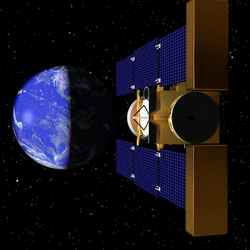
Artist’s impression of Stardust returning back to Earth. Image credit: NASA/JPL Click to enlarge
NASA’s Stardust mission is nearing Earth after a 4.63 billion kilometer (2.88 billion mile) round-trip journey to return cometary and interstellar dust particles back to Earth. Scientists believe the cargo will help provide answers to fundamental questions about comets and the origins of the solar system.
The velocity of the sample return capsule, as it enters Earth’s atmosphere at 46,440 kilometers per hour (28,860 miles per hour), will be the fastest of any human-made object on record. It surpasses the record set in May 1969 during the return of the Apollo 10 command module. The capsule is scheduled to return on Jan. 15, 2006.
“Comets are some of the most informative occupants of the solar system. The more we can learn from science exploration missions like Stardust, the more we can prepare for human exploration to the moon, Mars and beyond,” said Dr. Mary Cleave, associate administrator for NASA’s Science Mission Directorate.
Several events must occur before scientists can retrieve cosmic samples from the capsule landing at the U.S. Air Force Utah Test and Training Range, southwest of Salt Lake City. Mission navigators will command the spacecraft to perform targeting maneuvers on Jan. 5 and 13. On Jan 14 at 9:57 p.m. PST (12:57 a.m. EST on Jan. 15), Stardust will release its sample return capsule. Four hours later, the capsule will enter Earth’s atmosphere 125 kilometers (410,000 feet) over the Pacific Ocean.
The capsule will release a drogue parachute at approximately 32 kilometers (105,000 feet). Once the capsule has descended to about 3 kilometers (10,000 feet), the main parachute will deploy. The capsule is scheduled to land on the range at 2:12 a.m. PST (5:12 a.m. EST).
After the capsule lands, if conditions allow, a helicopter crew will fly it to the U.S. Army Dugway Proving Ground, Utah, for initial processing. If weather does not allow helicopters to fly, special off-road vehicles will retrieve the capsule and return it to Dugway. Samples will then be moved to a special laboratory at NASA’s Johnson Space Center, Houston, where they will be preserved and studied.
“Locked within the cometary particles is unique chemical and physical information that could be the record of the formation of the planets and the materials from which they were made,” said Dr. Don Brownlee, Stardust principal investigator at the University of Washington, Seattle.
NASA expects most of the collected particles to be no more than a third of a millimeter across. Scientists will slice these particle samples into even smaller pieces for study.
NASA’s Jet Propulsion Laboratory, Pasadena, Calif. manages the Stardust mission for NASA’s Science Mission Directorate, Washington. Lockheed Martin Space Systems, Denver, developed and operates the spacecraft.
For information about the Stardust mission on the Web, visit http://www.nasa.gov/stardust .
Original Source: NASA News Release
